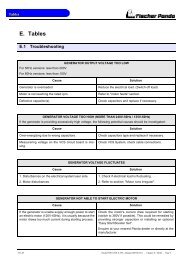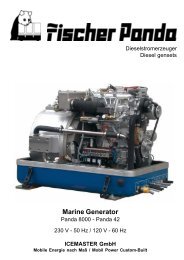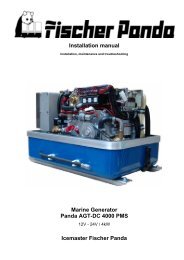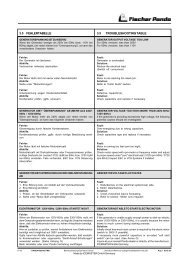Manual
Manual
Manual
Create successful ePaper yourself
Turn your PDF publications into a flip-book with our unique Google optimized e-Paper software.
Installation Instructions<br />
5.7 .Installation of the waterlock<br />
Unfortunately, it can occasionally occur that, because of an disadvantageous mounting position of the waterlock, sea<br />
water gets into the diesel engines’ combustion chamber. This disables the diesel engine by irreversible damages.<br />
Quite frequently, this leads to discussions during which the parties involved in the yachts’ construction or the installation<br />
of the generator have to explain themselves.<br />
One point in this situation can be clarified definitely:<br />
If sea water gets into the inner section of the engine, this is not possible due to constructional defects of the generator<br />
or to malfunctions on the engine itself. It can only reach the combustion chamber via the exhaust hose and thus<br />
get into the engine.<br />
Thereby, the position of the generator and the waterlock, as well as the arrangement of the cooling water and<br />
exhaust hoses play the decisive role.<br />
If the waterlock is arranged in an unfavourable position, the cooling water flowing back in the exhaust hose can rise<br />
so high, that it reaches the exhaust stack. Since at least one discharge valve is always open when the engine is shut<br />
off, the sea water has free access to the combustion chamber. By capillary action, this sea water then flows past the<br />
cocks and even reaches the engine oil in that way. (In fact, a surprisingly high oil level is a first indication of an<br />
upcoming catastrophe).<br />
If an usual high oil level can be detected and/or the oil is of a greyish colour, the engine must not be used<br />
anymore. This is a certain sign for cooling water that got into the oil pan. If the engine is started under these<br />
conditions, the water and the oil are mixed into an emulsion. The oil will quickly become so viscous that one<br />
will have to call it a paste. In this phase the fine oil hoses are blocked and a few moments later the machine<br />
gets destroyed because of insufficient lubrication. Before this happens, an immediate oil change should be<br />
made. Since the water can only reach the engine via the combustion chamber, it can be assumed that the<br />
compression rings will start to corrode. These effects have to be discussed with an engine expert. It will certainly<br />
be reasonable to immediately inject plenty penetrating oil through the intake stack and to slowly turn<br />
the engine with the starter motor.<br />
The cooling water can reach the exhaust area via the exhaust hose as well as via the cooling water feed.<br />
5.7.1 Possible cause for water in the exhaust hose<br />
5.7.1.1 Possible cause: Exhaust hose<br />
If the cause is the exhaust hose itself, the following points are to be checked at the hose:<br />
a) Position of the waterlock is too high. The water reaches the exhaust hose.<br />
b) Position of the waterlock is too far away from the middle of the generator. The water reaches the exhaust hose in<br />
tilted position.<br />
c) The waterlock is too small relating to the length of the exhaust hose.<br />
5.7.1.2 Possible cause: cooling water hose<br />
If the generator is not clearly installed 600 mm over the water line, the cooling water feed must be equipped with a<br />
„venting valve“ which is at least led out 600 mm over the water line. (This position must also be assured in every<br />
tilted position. Therefore, the venting valve should be located in the ships’ center line, so that it cannot move in tilted<br />
position).<br />
a) Position of the venting valve is too low. The water flows into the exhaust area when the ship is tilted.<br />
b) Position of the venting valve is too far from the ships’ center line. The water reaches the exhaust area when the<br />
ship is tilted.<br />
c) The venting valve does not work, because it jams or it is clotted. (The venting valve’s function needs to be<br />
checked regularly.)<br />
7.5.12 Panda_4000s_PMS_SCB_FCB_eng.R04 - Kapitel/Chapter 5: Installation Instructions Seite/Page 63

















